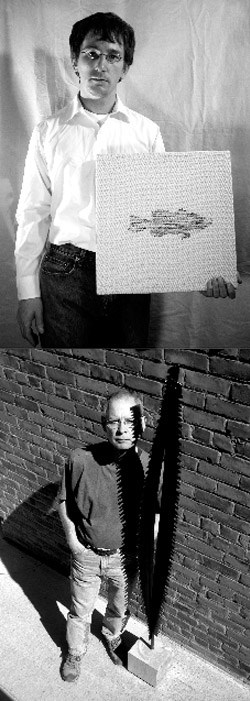NEWS RELEASE
ALBERTA HOUSE
**************************** Fish stories and other works
“Fish Stories and Other Works” is the June exhibition at the Olive M. Craig Gallery at Alberta House in the Michigan Soo.
It features the work of two Sault artists, William Gerrish and Jeremy Ripley.
Bill Gerrish’s work includes framed assemblages and free-standing sculptures, all of which are made of found objects.
Jeremy Ripley is showing weavings made on a loom that incorporate the fish motif.
A fish story is usually thought to be an implausible, boastful, embellished story.
Bill’s stories are tales in words and objects that are reminiscences of time spent fishing with his father or by himself.
The viewer will be able to read in the exhibit catalog Bill’s intention for each piece along with some of his fishing stories.
Included are actual pages from fishing journal jottings, antique fishing tackle, fly fishing line and flies.
There are saw blades reminiscent of fish jaws, actual fish teeth and bones, fish carvings, and a multimedia piece dream catcher, reclaiming his father’s fishing creel as an art object.
The viewer is invited to peer inside the creel to experience a visual memory.
Jeremy’s stories are subtle wood block prints on fiber that are abstract portraits of fish in their habitats.
Having returned home to Sault Ste. Marie in recent years to care for his aging parents, Bill Gerrish was surrounded by reminders of his past in the form of items saved by his parents.
He discovered there an invaluable resource of memories and artistic materials.
Their garage was turned into a studio by Bill, where he creates sculpture in stone, wood, and metal, and assemblages of collected materials showing the patina of time.
Working in his studio has come to be therapeutic for him.
It is a place he calls his sanctuary.
He also has found time to do graphic design work, create custom shadow boxes for clients, and for one of his favorite pastimes, fishing.
Bill says he feels “a sense of solitude” while fishing, but also “a sense of oneness with nature.”
About four years ago, Bill was encouraged by artist Tom Marshall to consider displaying his work.
A joint show was considered, and Jeremy Ripley, also a sculptor, was suggested.
After hearing Detroit poet M.L. Liebler perform his autobiographical poetry to musical accompaniment at Bayliss Public Library, Bill was inspired to focus on his own autobiographical stories in his future art show.
Bill came up with the show title, “Fish Stories,” and Jeremy’s fiber art fit the theme.
Over time, the show evolved from Bill’s shadow boxes, such as “Fish Story,” and his sculptures, to related works, such as his Memento series that became the “Other Works.”
During the creation of the works for the show, Bill says he segued from the original theme of fish but sensed a need to accept the gift of inspiration and includes these “Other Works.”
All the pieces in the show are constructed of items that he found or was given by friends.
His framed abstract assemblages pack a punch that is pleasing to the eye in their balance, mixed textures, muted colors, and symbolism.
They are the detritus of life transformed into high art.
Both artists are inventive, playful, poetic, and enjoy pushing their technique and challenging themselves, often in laborious physical endeavors, such as their sculptures of stone, wood, and metal, or the weavings that take many hours of patient labor.
Their works deal with history, from the patina of found objects with evidence of rust, age, and use - the pencil marks, pinholes, shine of natural wear - to explorations of the ancient art of weaving.
Jeremy discovered weaving while in college at Northern Michigan University and has continued with it, devoting an entire room of his house to his looms and related equipment.
He enjoys exploring the science, math, and art of the ancient process.
Almost as much preparation time goes into planning, measuring, rolling yarn, and setting up a loom as in the actual process of weaving fabric.
In recent years, he produced and exhibited lacy weavings.
Jeremy talks about weaving: “As a process that is extremely repetitive motion threading a loom with hundreds of threads and weaving the cloth through the shuttles back and forth from side to side. Some may find it too tedious, but I find it rather relaxing. It is a process I love.”
Weaving provides a counterpoint to his day job of upholstery work by also allowing him to explore his creativity.
Jeremy has about 50 cotton weavings of various sizes in the show, which are stretched like painters’ canvases onto wooden stretchers for mounting on the wall.
They can be hung in groupings or singly, and may be framed or unframed.
Each one has been printed with a fish or a school of fish during the weaving process.
Jeremy carved various fish shapes out of wood, applied textile paint to the wood carving, and pressed the fish shape into the warp threads while weaving.
This technique of his own invention creates impressions of fish within the textured pattern of the fabric.
The viewer wonders how the printed weavings were created and is transported further into the artwork.
To continue reading this release, please click here
